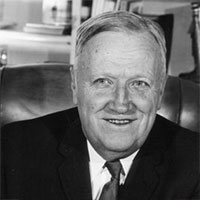Frank Spedding
Frank Harold Spedding was a Canadian American chemist. He was a renowned expert on rare earth elements, and on extraction of metals from minerals. The uranium extraction process helped make it possible for the Manhattan Project to build the first atomic bombs.
Frank Harold Spedding, an American chemist who, during the 1940s and ’50s, developed processes for reducing individual rare-earth elements to the metallic state at low cost, thereby making these substances available to industry at reasonable prices. He also helped to purify the uranium used in 1942 for the first self-sustaining nuclear chain reaction experiment.
After studying at several American institutions of higher education, Spedding held various teaching and research positions until he became professor of physical chemistry at Iowa State University of Science and Technology, Ames, in 1941. The following year he joined other scientists at the University of Chicago who were seeking to determine whether a self-sustaining nuclear chain reaction was possible. Dividing his time between Chicago and Ames, Spedding, together with Harley A. Wilhelm and C.F. Gray, found a way to produce very pure uranium metal; that substance was used in the first self-sustaining nuclear chain reaction experiment at Stagg Field, University of Chicago, on Dec. 2, 1942.
After World War II Spedding returned to Ames, where research by his group resulted in the theoretical and practical advances that made possible the production of rare-earth metals at low cost. Spedding was director of the Institute for Atomic Research and of the Ames Laboratory of the Atomic Energy Commission at Iowa State University until 1968, when he became principal scientist at the Ames Laboratory. From 1968 to 1976 he was a member of the Committee on Radioactive Waste Management for the National Academy of Sciences.
Spedding developed an ion-exchange method of separating and purifying rare earth elements using ion-exchange resins, and later used ion exchange to separate isotopes of individual elements, including hundreds of grams of almost pure nitrogen-15. By February 1942, the United States had entered World War II, and the Manhattan Project was building up. At the University of Chicago, Arthur H. Compton established its Metallurgical Laboratory. Its mission was to build nuclear reactors to create plutonium that would be used in atomic bombs. He etablished chemistry Division at Iowa state college,Aimes and recruited two more chemists to aisst him. They were able to reproduce results in August 1942, and by September, the Ames Project had produced a 4.980-kilogram (10.98 lb) ingots. By 1945 they were able to produce two million pound of Uranium

Frank Spedding
Date of Birth: 22 Oct 1902
Birth Place: Hamilton, Canada
Proffession: American chemist
Nationality: United Kingdom
Death: 15 December 1984, Ames, Iowa, United States


